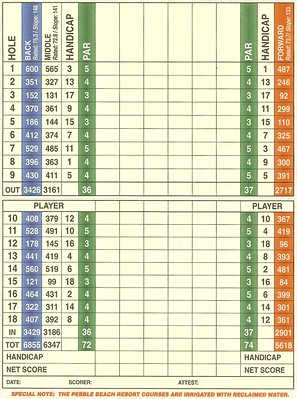
Newcomers and causal players often debate “What is a good score in golf?” The real answer? “It depends.” Course difficulty, playing conditions, and player handicap all come into consideration.
My opinion up front: If you are a casual golfer who breaks 100, that is pretty good. If you play all the time, a good golf score moves well into the 80s for 18 holes. As a high single digit handicap, my “good” rounds are high 70s/low 80s at difficult courses. At the end of the day, I can find better golfers who think that I suck and worse golfers who think I am pretty good. You can’t please everybody.
But most golfers can’t break 100, so if you are doing that on a relatively consistent basis then that is a pretty good level of play.
For those who want to get deeper into it, we’ll explore what constitutes a good score in golf, considering factors such as the course’s layout, the player’s skill level, and the conditions under which the game is played.
Understanding Golf Scores
Before we can define what a “good” score is, it’s essential to understand how scoring works. They are typically denoted in relation to par, the predetermined number of strokes an expert golfer is expected to require to complete a hole or course. Par values for holes are typically set at three, four, or five, with the total par for a course usually ranging between 70 and 72. Individual hole scores can be described as follows:
- Birdie: One stroke under par.
- Eagle: Two strokes under par.
- Bogey: One stroke over par.
- Double Bogey: Two strokes over par.
A golfer’s score for a round is the sum of their scores on each hole, often compared to the course par to provide context.
What is a Good Score in Golf for 18 Holes?
This is highly subjective and varies based on several factors, including the golfer’s skill level, the course difficulty, and the playing conditions. However, for the sake of generalization, scores can be categorized based on the skill levels of players:
- Professional Golfers: For professionals, this is typically under par, often in the range of 65 to 70 strokes for a round, depending on the course difficulty.
- Amateur Golfers: Amateurs have a wider range of outcomes. A score of 80 to 90 might be considered positive for a casual amateur, while more competitive amateurs might aim closer to par.
- Beginners: For beginners, breaking 100 is often an initial milestone that signifies a good day.
It’s important to note that golf is unique in that it accommodates players of all skill levels through the use of handicaps. A handicap allows players of different abilities to compete on a more even footing by adjusting scores based on their average performance.
Course Difficulty
The difficulty of a golf course plays a significant role in determining what constitutes a good score. Courses are rated with a course rating and slope rating, which provide a gauge of the course’s difficulty for a scratch golfer (a golfer who can play to a course par) and a bogey golfer (a golfer with a handicap of about 20 for men and 24 for women), respectively. A course with a higher slope rating will generally be more challenging for most players, and scoring close to par on such a course would be an impressive feat.
Playing Conditions
The conditions under which a round of golf is played can greatly affect scores. Weather conditions like wind, rain, and temperature can make a course more challenging. Additionally, the course’s setup, including pin positions and tee box locations, can vary daily, influencing what would be considered a good score on any given day.
Aim for Personal Bests
Ultimately, the best way to gauge a good score in golf is to compete against yourself. Setting personal goals based on your skill level, experience, and familiarity with the course you’re playing can provide a more satisfying measure of what constitutes a good score for you. As you improve, these goals can be adjusted to reflect your new skill level, keeping the game challenging and rewarding.
Historical Perspectives on Good Golf Scores
The idea of what is considered a good score in golf has also evolved over time. A lot of things have come around that make golf easier, such as:
- More forgiving clubs (from driver down to putter)
- Better golf balls
- Availability of instructional information on YouTube and Instagram
- Higher focus on fitness in golf
Also, historical analysis shows that average scores for professional tournaments have decreased over the decades – players have just gotten better.
This will likely continue. Scores that are good today will likely look worse tomorrow.
Conclusion
What constitutes a good score in golf varies widely and is influenced by a player’s skill level, the course being played, and the conditions on the day of play. While professional golfers may aim for scores significantly under par, amateur and beginner golfers should focus on personal improvement and setting achievable goals based on their current abilities. Remember, golf is a game of personal achievement, where the ultimate opponent is the course itself. Striving for personal bests, understanding the influence of course difficulty, and adapting to playing conditions can all contribute to defining what a good score is for you. Whether you’re just starting or have been playing for years, the quest for a good score in golf is an ongoing journey of skill development, strategy, and, most importantly, enjoyment of the game.
Leave a Reply